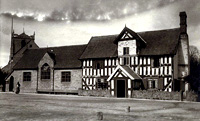News
Webwatch

One of the 'Where in Devon? photographs the Westcountry Studies Library's 'Location? Location? Location?' exhibition. If you can identify the location, please contact Westcountry Studies Library, Exeter Central Library, Castle Street, ExeterEX4 3PQ, tel: 01392 384216, E-mail: westcountry.library@ devon.gov.uk.
The Westcountry Studies Library in Exeter has put its 'Location? Location? Location?' exhibition, which is an annual display of unidentified images of places and buildings in its collections, online at Flickr. In 2008 fifty-four images were posted, of which more than half have so far been identified. This innovative approach by staff resulted in regional cover on television and a good response from the public.
Solihull's Heritage and Local Studies Service is also making use of Flickr, with fifty images posted online, and is currently appealing for photographs of local interiors for a planned exhibition to be called 'Solihull behind closed doors'.
Mike Royden's Local History Pages is a website we have always liked and there has been a reciprocal link with Local History Online for some time, so what makes us mention it in Webwatch? The answer is in another website we have come across called Historic Liverpool, which is innovative in a number of ways. As well as a blog by the site's originator, Martin Greaney, there is a growing bibliography and a page of related links, including praise for Mike's website (hence the mention), but best of all there is an interactive map with an overlay of the city's historic townships onto which Martin has marked historic parks, listed building and scheduled monuments. You can then click on these to see more information. An impressive site which will get better as more information is added.
Looking at Buildings has been created by Pevsner Architectural Guides and is an online guide to building types, architectural styles, building materials, methods of construction and introduction to buildings in seven English cities and parish churches.
Picture Sheffield has been re-launched with over 36,000 images 'now completely available on the internet'. The images range from the earliest reproductions to photographs of present-day Sheffield. Picture Sheffield dates back to 1998 and first went online in 2000.
To understand Gypsies and Travellers today, it is very important to know about their history; where they come from, their traditions, customs and beliefs and how they have been viewed and treated over the ages. By chance we came across an online gypsy-traveller history which may be of interest. The charity, Friends, Families and Travellers, 'seek(s) to end racism and discrimination against Gypsies and Travellers, whatever their ethnicity, culture or background, whether settled or mobile, and to protect the right to pursue a nomadic way of life'. As a group, they are on the margins of local history, rarely being mentioned, whilst being ever present in the lives of many communities. They deserve the attention of local historians, so that their contribution to local life can be recorded and better understood.
After the Conflict is a personal blog by Ian Lewis devoted to Cumbrian war memorials, which he describes as 'a gentle jaunt through a poignant aspect of Cumbria's history'. Ian goes onto say 'I have set up this blog to share what I find and to discover more. Feedback is great, I have learnt a lot from peoples comments. Also, if recorded, they are less likely to be destroyed, as many have been.' A wonderful example of the uset that local historians can make of the Web. I found his blog after reading an article by Ian in the Cumbria Local History Federation Bulletin No.50, Spring 2009.
The Gazetteer for Scotland is a very impressive online geographical encyclopaedia, featuring details of towns, villages and some geographical features like lochs and bens across the entire country. Simply type in a name and off you go. As well as contemporary and historic maps to choose from, in many cases there are photographs and lots of other information about historic events and present-day attractions. If you have any associations with Scotland or want to know more, perhaps before planning a visit, this is the website to visit.
20 April 2009

